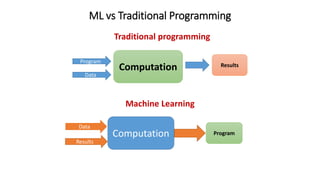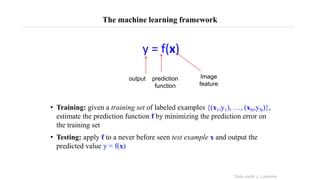Ad
Introduction to machine learning-2023-IT-AI and DS.pdf
- 1. Machine Learning Abdulkerim M.(PhD) Feb, 2023 Faculty of Computing Bahir Dar Institute of Technology Bahir Dar University
- 2. What do you know about machine learning?
- 3. AI vs ML vs DL
- 4. AI vs ML vs DL
- 5. Machine learning vs Deep Learning Source: https://semiengineering.com/deep-learning-spreads/
- 6. What is machine learning ? • It means that ML is able to perform a specified task without being directly told how to do it. • Example: • Distinguish between spam and valid email messages. Given a set of manually labeled good and bad email examples, an algorithm can automatically learn a set of rules that distinguish them. • Language Identification ( Amharic, Ge'ez, Tigrigna, Afar, etc) ( How?) 6 • Arthur Samuel (1959) defined machine learning as “a sub-field of computer science that gives computers the ability to learn without being explicitly programmed.”
- 7. What is machine learning ? • A widely accepted formal definition by Tom Mitchell (1997, professor of Carnegie Mellon University): • A computer program is said to learn from experience E with respect to some class of tasks T and performance measure P, if its performance at the tasks T , as measured by P, improves with the experiences. • In short • A set of computer programs that automatically learn from past experiences (examples or training corpus) • Example: According to this definition, we can reformulate the email problem as the task of identifying spam messages (task T) using the data of previously labeled email messages (experience E) through a machine learning algorithm with the goal of improving the future email spam labeling (performance measure P) 7
- 8. What is machine learning ? ML aims to select, explore and extract useful knowledge from complex, often non-linear data, building a computational model capable of describing unknown patterns or correlations, and in turn, solve challenging problems. This learning process is often carried out through repeated exposure to the defined problem (training dataset), allowing the model to achieve self- optimization and continuously enhance its ability to solve new, previously unseen problems (test dataset). 8
- 9. Applications of Machine learning 9 Multimedia event detection Image segmentation Natural language processing Object detection and recognition Surveillance and security system Character recognition Predication (weather, medical, agricultural yield) Spam Detection Speech Recognition MT sentiment classification Cancer detection/classification Face recognition
- 10. Probability Theory in Machine Learning • Probability is key concept is dealing with uncertainty • Arises due to finite size of data sets and noise on measurements • Probability Theory • Framework for quantification and manipulation of uncertainty • One of the central foundations of machine learning
- 11. • Probability. The word probability is actually undefined, but the probability of an event can be explained as the proportion of times, under identical circumstances, that the event can be expected to occur from the known population. • It is the event's long-run frequency of occurrence. • For example, the probability of getting a head on a coin toss = 0.5 • Probability vs. Statistics. • Probability, deals with predicting the likelihood of future events. • Statistics, you draw inferences about the population from the sample or analysis of the frequency of past events Basic Concepts on Probability
- 12. Probabilistic vs Statistical Reasoning • Suppose I know exactly the proportions of car makes in Addis Ababa. Then I can find the probability that the first car I see in the street is 'Vitz'. This is probabilistic reasoning as I know the population and predict the sample. • Now suppose that I do not know the proportions of car makes in Addis Ababa, but would like to estimate them. I observe a random sample of cars in the street and then I have an estimate of the proportions of the population. This is statistical reasoning
- 13. Key Terms Number of outcomes in event ( ) . Total number of outcomes in sample space P E = • Empirical (or statistical) probability an event is an estimate that an event will occur based upon how often the event occurred after collecting data from an experiment in a large number of trials. This type of probability is based upon direct observations. Each observation in an experiment is called a trial/total frequency and is given by, • Example: Next-slide Frequency of Event ( ) Total frequency E P E = • Classical (or theoretical) probability is used when each outcome in a sample space is equally likely to occur. The classical probability for event E is given by, Example: Find the probability of rolling a 4 on a fair die. Answer: There are 6 possible outcomes when rolling a die: 1, 2, 3, 4, 5, and 6. The only favorable outcome is rolling a 4. = 1/6 ( What do you think about rolling even number?)
- 14. Key Terms Simple probability. P(A). The probability that an event (say, A) will occur. Joint probability. P(A and B). P(A ∩ B). The probability of events A and B occurring together. Conditional probability. P(A|B), read "the probability of A given B." The probability that event A will occur given event B has occurred. What is the probability of that the students favorite sneaker is brand A or B?
- 15. Probability Distributions • The probability distribution for a random variable X describes how the probabilities are distributed over the values of the random variable X. • The probability distribution for a discrete random variable is described with a probability mass function (PMF). If the random variable is continuous then what could be the probability distribution? • The need of probability distribution: • To calculate confidence intervals for parameters • To calculate critical regions for hypothesis tests
- 16. ML vs Traditional Programming Traditional programming Machine Learning Computation Program Data Results Computation Data Results Program
- 17. Related Fields psychological models data mining cognitive science decision theory information theory databases machine learning neuroscience statistics evolutionary models Optimization Machine learning is primarily concerned with the accuracy and effectiveness of the computer system in performing complex tasks. 17
- 18. 18 Statistics vs. Machine Learning Statistics Machine Learning Inference Prediction Small data sets/low-dimensional data Large data sets/high-dimensional data Specific assumptions and hypotheses Large flexibility and free from a priori assumptions/hypothesis free Computation of the P values to accept or reject a null hypothesis ROC curve, cross-validation, etc. Fitting a parsimonious model to produce an easy to understand and interpretable results Considers complex non-linear patterns, a sophisticated model that is not easy to understand or interpret. • Inference: drawing conclusions about something in the text using the text evidence, your own background knowledge and common sense. Inferences are made about what happened in the past or what is currently happening. • Prediction: using the text evidence ,background knowledge and common sense to make a guess to what will happen in the future.
- 19. Classes of Machine Learning problem 19 • Supervised Learning • Unsupervised Learning • Semi-supervised Learning • Reinforcement Learning
- 20. Classes of machine learning Problem Supervised Learning • Learn to predict output when given an input vector • Training data includes desired outputs
- 22. 22 Classes of machine learning Problem Clustering Dimensionality reduction Unsupervised Learning • The aim is to uncover the underlying structures (classes or clusters) in the data • Training data does not include desired outputs. This is the new frontier of machine learning because most big datasets do not come with labels.
- 24. • Semi-supervised Learning • Desired outputs or classes are available for only a part of the training data. • This approach is useful when it is impractical or too expensive to access or measure the target variable for all participants Machine learning structure
- 25. Machine learning structure Reinforcement Learning • Learning method that interacts with its environment by producing actions and discovers errors or rewards. • On the basis of trial and error, to discover what actions maximize reward and minimize the penalty.
- 26. The Learning Problem • Given <x,f(x)> pairs, infer f x f(x) 1 1 2 4 3 9 4 16 5 ? Given a finite sample, it is often impossible to guess the true function f. Approach: Find some pattern (called a hypothesis) in the training examples, and assume that the pattern will hold for future examples too.
- 27. The machine learning framework y = f(x) • Training: given a training set of labeled examples {(x1,y1), …, (xN,yN)}, estimate the prediction function f by minimizing the prediction error on the training set • Testing: apply f to a never before seen test example x and output the predicted value y = f(x) output prediction function Image feature Slide credit: L. Lazebnik
- 28. Learning—A Two-Step Process • Model construction: • A training set is used to create the model. • The model is represented as classification rules, decision trees, or mathematical formula • Model usage: • the test set is used to see how well it works for classifying future or unknown objects
- 29. 29 Step 1: Model Construction Training Data NAME RANK YEARS TENURED Mike Assistant Prof 3 no Mary Assistant Prof 7 yes Bill Professor 2 yes Jim Associate Prof 7 yes Dave Assistant Prof 6 no Anne Associate Prof 3 no Classification Algorithms IF rank = ‘professor’ OR years > 6 THEN tenured = ‘yes’ Classifier (Model)
- 30. 30 Step 2: Using the Model in Prediction Classifier model Testing Data NAME RANK YEARS TENURED Tom Assistant Prof 2 no Merlisa Associate Prof 7 no George Professor 5 yes Joseph Assistant Prof 7 yes Unseen Data (Jeff, Professor, 4) Tenured?
- 31. Challenges in Machine Learning • Efficiency and scalability of machine learning algorithms • Handling high-dimensionality • Handling noise, incomplete and imbalanced data • Pattern evaluation and knowledge integration • Protection of security, integrity, and privacy in machine learning • Data acquisition and representation issues • Degree of interpretability for predictive power • Deployment issues
- 32. Basic Steps in Machine Learning 32 1. Data collection “training data”, mostly with “labels” provided by a “teacher”; 2. Data preprocesing Clean data to have homogenity 3. Feature engineering Select represenatative features to improve performance 4. Modeling choose the class of models that can describe the data 5. Estimation/Selection find the model that best explains the data: simple and fits well; 6. Validation evaluate the learned model and compare to solution found using other model classes; 7. Operation Apply learned model to new “test” data or real world instances
- 33. Basic Mathematics for Machine learning 33 You are strongly advised to read • Linear Algebra • Calculus






































![ViT (Vision Transformer) Review [CDM]](https://cdn.slidesharecdn.com/ss_thumbnails/vitreviewcdm-201012184226-thumbnail.jpg?width=560&fit=bounds)


![XGBOOST [Autosaved]12.pptx](https://cdn.slidesharecdn.com/ss_thumbnails/xgboostautosaved12-230501140101-a562c3ba-thumbnail.jpg?width=560&fit=bounds)

































































